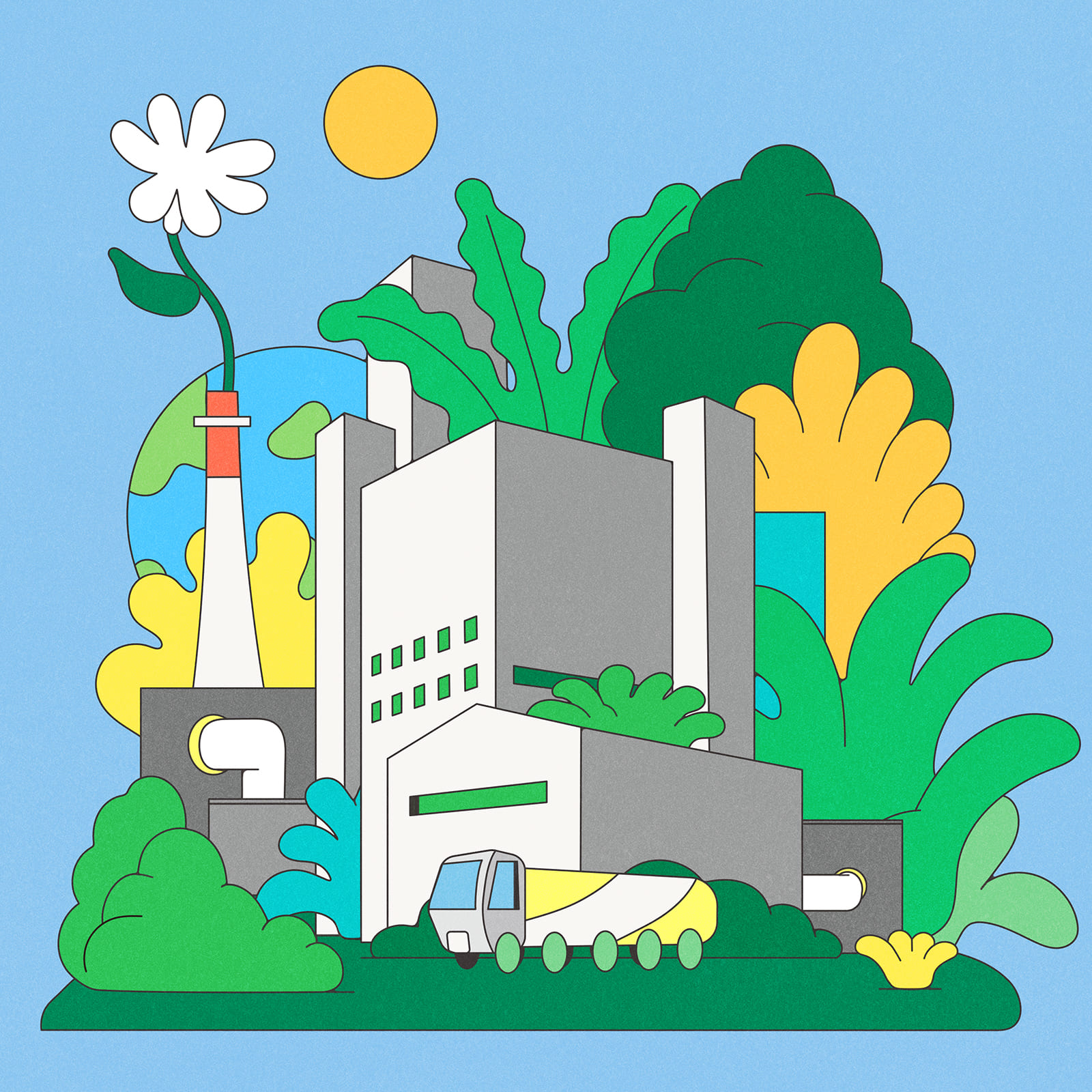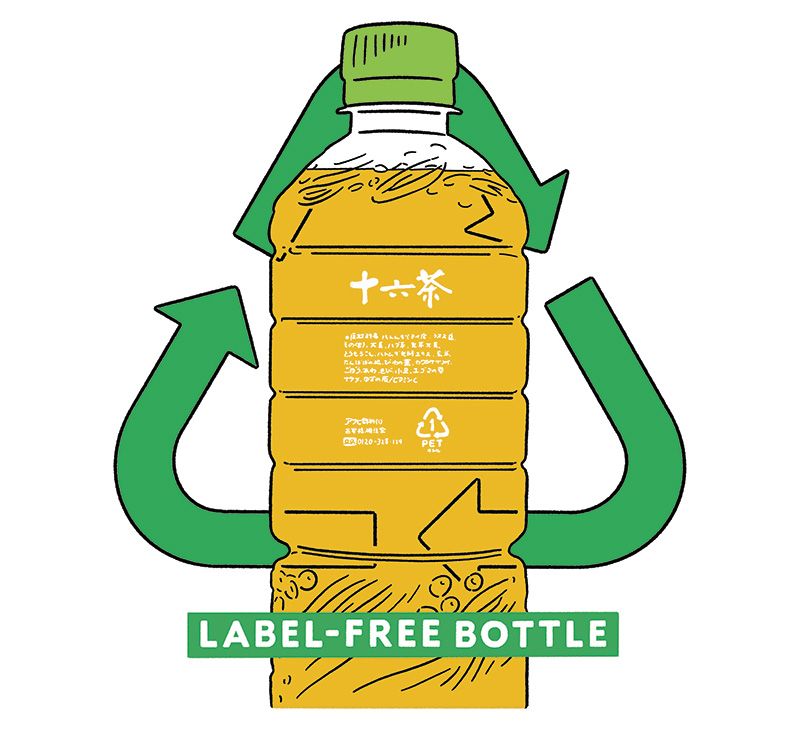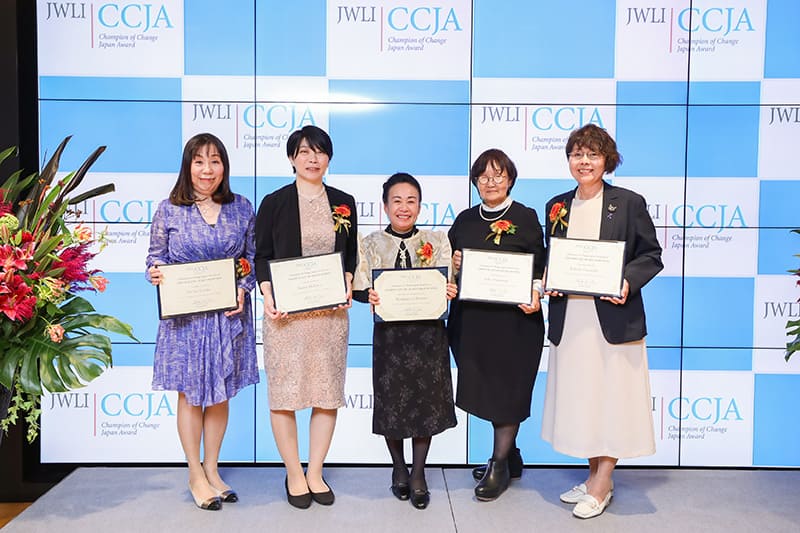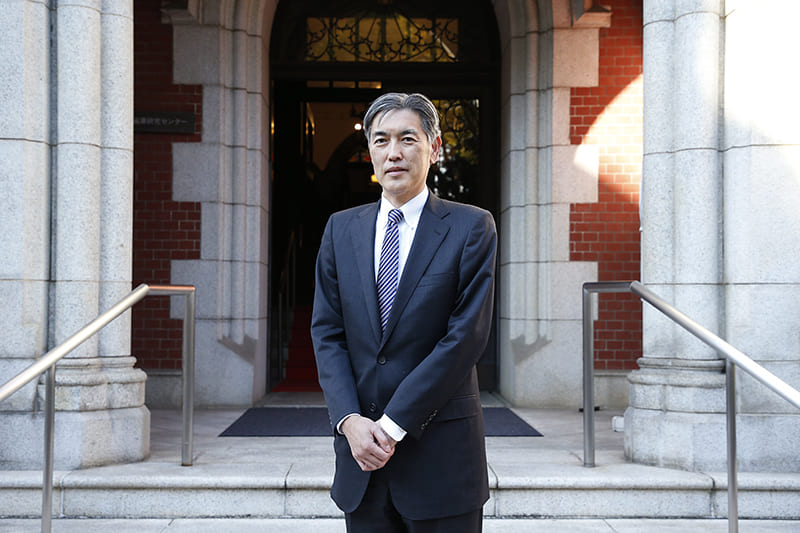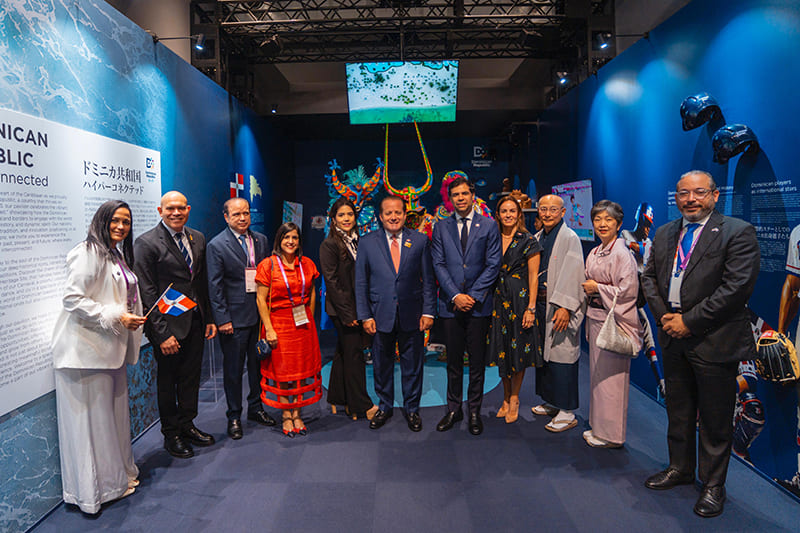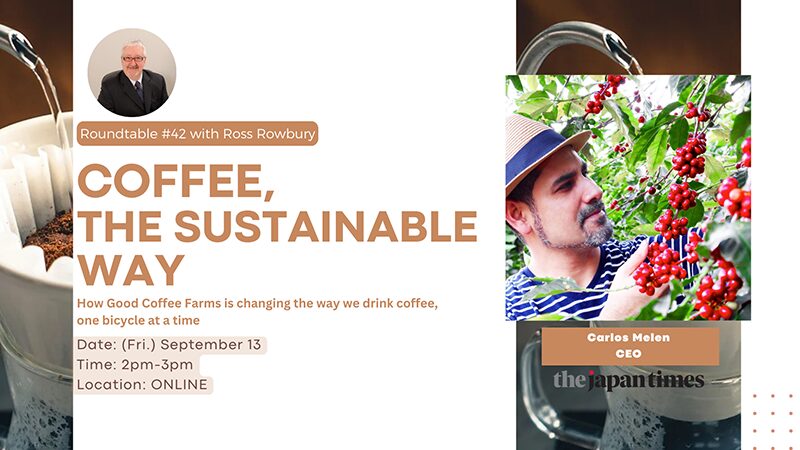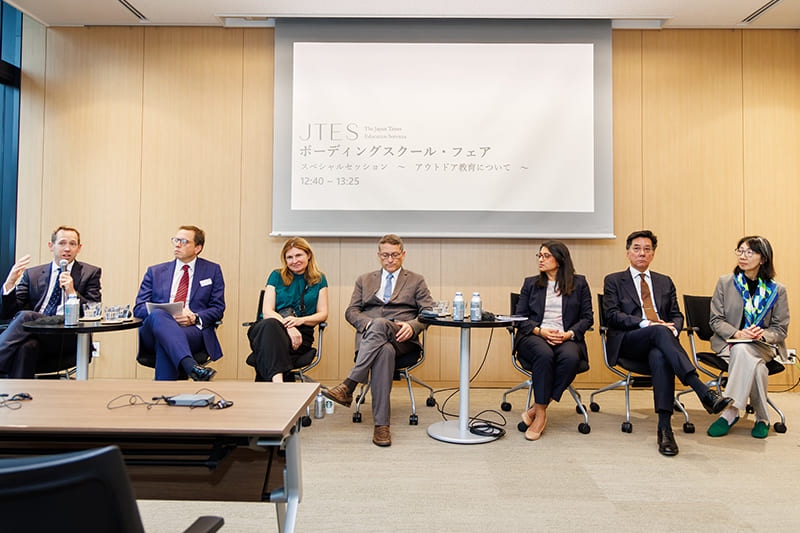February 21, 2025
Kubota tackles food, water and environmental issues
VOL. 15: Kubota Corp.

Kubota’s strong points
1.Drew attention at the CES trade show with a next-generation transporter and an automated electric tractor equipped with AI
2.Made CDP’s A lists for climate change and water security in 2023
3.Promotes low-carbon farm and construction machinery despite technical hurdles
4.Has set up new businesses to support farmers and recycle resources, and contributes to water conservation

On Jan. 8, Kubota Corp.’s booth drew a surge of attention at the CES technology trade show in Las Vegas.
The major Japanese maker of agricultural and construction machinery debuted at CES in 2024. The highlight of its new exhibits was a demonstration of the KATR, an all-terrain robot carrier that won the event’s Best of Innovation award. The crowd roared over the technology of the next-generation transporter, which can keep loads of up to 240 kilograms level even while moving on rough slopes.
Kubota also unveiled the Agri Concept 2.0 electric tractor, which can drive autonomously and suggest tasks appropriate to crop and weather conditions. Reporters flocked to interview Kubota President Yuichi Kitao.
Cutting-edge technology, however, is not exactly what Kubota is after. The robot carrier and Agri Concept 2.0 are the result of its efforts to solve problems for farmers and help achieve sustainable farming.
Since its establishment in 1890, Kubota has introduced a wide range of products and services related to food, water and the environment.
It has a strong presence in its original waterworks business, making about 60% of the water pipes in Japan and 80% of the treatment equipment in advanced water purification facilities. With its high technology and strong track record, Kubota now supports the water infrastructure of many countries around the world.
Farm, industrial and other machinery is now its mainstay, accounting for 87% of sales. Kubota has manufactured 5.6 million tractors and for 22 years in a row has sold the most mini excavators in the world.
Kubota sells these products in over 120 countries, and overseas sales have grown to account for 79% of its total sales of ¥3 trillion ($19 billion) in 2023.
As it increasingly makes its presence felt internationally, Kubota is also gaining recognition for its sustainability initiatives.
The international nonprofit CDP put Kubota on its 2023 A lists, announced in February 2024, in the water security category for the fifth time and the climate change category for the first time. Kubota was one of just 61 companies making both A lists, and the only farm machinery maker.
Most agricultural and construction machinery is powered by diesel engines that emit substantial amounts of carbon dioxide. The fact that CDP evaluated Kubota highly even though it belongs to an industry that has a strong impact on the environment speaks volumes about Kubota’s serious commitment to sustainability efforts.
Management centered on ESG
Agriculture is linked to global issues like the environment and food security. Agriculture and forestry are estimated to be responsible for 20% of greenhouse gas emissions, and climate change is bringing natural disasters and crop shortages in emerging countries.
In Japan, the number of farmers has been steadily decreasing due to aging and a shortage of successors, leading to a decline in crops. Abandoned farmland leads to a collapse of the ecosystem and also has increased the risks of landslides and ecological collapses.
Aiming to address these issues, Kubota in 2021 formulated a long-term vision for 2030, GMB2030, and a midterm business plan running to the end of 2025, pledging to shift to business operations that emphasize “KESG” — a Kubota-style commitment to environmental, social and governance awareness (see the article in the box).
For example, it is in the process of replacing coke-burning furnaces with electric furnaces, which emit 20% to 30% less carbon, to melt iron for making machinery and water pipes.
Still, most of Kubota’s farm and construction equipment has diesel engines, whose environmental impact is far larger.
Kubota’s Scope 1 and 2 direct emissions totaled about 560,000 tons of carbon dioxide in 2023, far more than the 42.3 million tons of Scope 3 indirect emissions from its supply chains. About 87% of this was from the use of its products.
Farm and construction machinery has been decarbonized more slowly than passenger cars. The reasons are specific to these products.
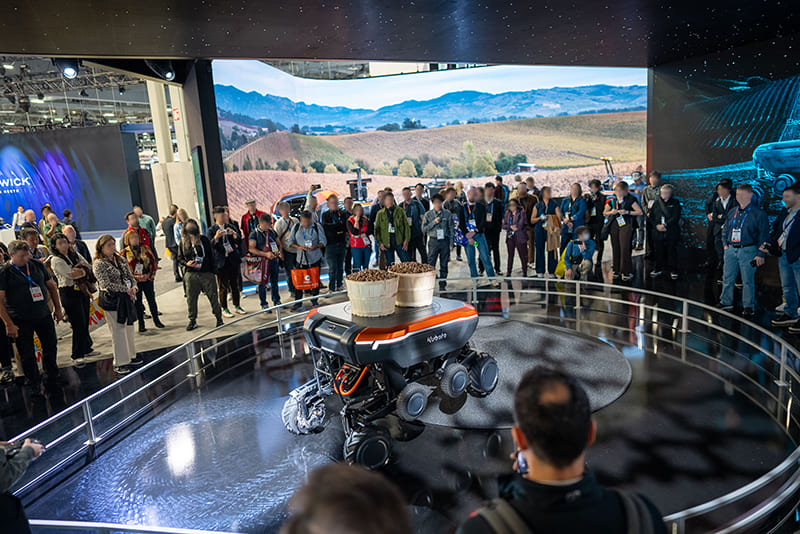
© KUBOTA
Exhaust gas regulations
First, heavy-duty agricultural and construction machinery requires significant power. Batteries and electric motors can operate for a shorter time and are not yet suitable under the conditions in which these machines are used.
Another problem is that charging stations are rarely installed in the rural and mountainous areas where these machines are often used, according to Kubota Director Masato Yoshikawa.
“For example, if the battery lasts for only three hours, would you be willing to take an hour to go home to recharge it (in the middle of work)? That would deter customers from buying the product,” said Yoshikawa, who served as representative director and executive vice president in charge of ESG promotion until 2024. “So we need further innovation in batteries themselves, and we have to wait until the charging infrastructure is developed (to a more practical degree). So that’s the situation we are in.”
But Kubota isn’t just sitting around waiting for advances. It is conducting its own research and development with a multifaceted and well-thought-out approach.
For starters, Kubota has been quick to make its industrial diesel engines that produce 100 horsepower or less comply with emissions regulations in various countries.
Kubota sells more than half of the industrial diesel engines it makes to other companies, and thus has a significant impact on farm and construction equipment around the world.
Evolution of engines
Kubota is working on decarbonization from different angles, labeled “pure engine,” “hybrid” and “fuel” solutions.
The pure engine solution is aimed at improving the fuel efficiency of diesel engines. A combustion technology unique to Kubota called TVCR improves fuel efficiency by about 5% compared to conventional engines. The technology is used in electronically controlled compact engines, such as the D902-K, introduced in 2022, and the D1105-K, introduced in 2024. These models comply with tough emissions regulations in the United States, Europe and China.
Kubota is also working on hybrid engine technology. It developed a “micro hybrid engine,” in which an electric motor kicks in to assist the primary diesel engine the moment it detects a high load.
Kubota has also developed a hybrid that can switch to an electric motor. This system uses a diesel engine to generate electricity for the batteries. A prototype was exhibited at a trade show in Munich in 2022.
Kubota is also working to make its engines compatible with alternative fuels. All of the diesel engines it currently offers are compatible with “hydrotreated vegetable oil,” a biodiesel fuel made by adding hydrogen to vegetable oil.
“We believe we are the leader in low-carbon and hybrid technology for compact diesel engines,” Yoshikawa said.
Kubota is also working on technology to shift itself away from fossil fuels entirely.
In September 2022, the company announced it would introduce an electric tractor, Japan’s first. In April 2023, it launched a long-term rental service for the tractor for European local governments. Later that year, it announced it would introduce an electric mini excavator to the European market the next spring. This expanded its electric lineup to construction machinery.
But Kubota still faces a hurdle, according to Yoshikawa.
“There is demand for small electric agricultural and construction machinery in regions where regulations are strict, such as Paris, but are they commercially viable elsewhere in the world? No, they aren’t, for now,” the director said.
Engines that run on hydrogen are seen as a promising, viable alternative.
When hydrogen reacts with oxygen, energy is released, emitting only water vapor. There are two types of technologies for generating power this way: fuel cells and hydrogen internal combustion engines (HICE).
In September 2022, Kubota announced it was developing an industrial-use HICE.
As a HICE is simply a type of internal combustion engine, one can be installed in an existing tractor, for example. Development of the technology is progressing steadily, and in January Kubota unveiled its prototype at the CES in Las Vegas and the Hydrogen & Fuel Cell Seminar in California.
Last March, Kubota also unveiled a prototype tractor with electric motors powered by fuel cells. That project qualified for subsidies from the New Energy and Industrial Technology Development Organization in 2021 and has now shifted to the testing phase.
As next-generation technologies, fuel cells and hydrogen internal combustion engines have both advantages and disadvantages, but Kubota is betting on them both.
Kubota casts wide nets for its development projects. Issues do, of course, crop up in terms of performance, cost and infrastructure, and technologies may not find wide use quickly. But the company believes their time will come. “We’re going to do anything we can do” to make that happen, Yoshikawa said.
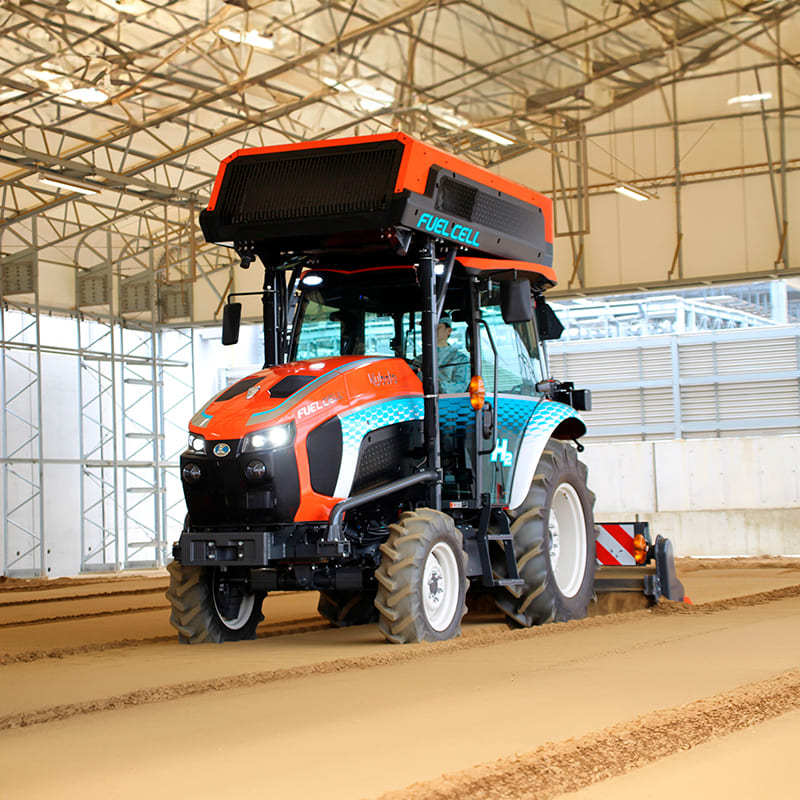
© KUBOTA
Solar power, furnaces
Kubota contributes to sustainability in diverse ways. In addition to developing next-generation farm and construction machinery, it has initiated projects supporting sustainable farming operations and the circular economy. One such initiative is a farm-based solar power generation project that takes advantage of Kubota’s connections with farmers.
The project helps agricultural corporations and farmers set up solar power facilities on their land, and Kubota buys the electricity to use at its plants.
Currently, Kubota plans to expand the project to 50 locations in and around Tochigi Prefecture by April, targeting a total generation capacity of 5 megawatts. Kubota estimates the facilities will reduce emissions of carbon dioxide by 2,600 tons annually. It aims to buy ¥5 billion in electricity by 2030.
“(This initiative) helps maintain farming, an essential industry, and contributes to securing food,” Yoshikawa said. “It helps us raise the percentage of renewable energy consumption. It may even lead to moves to set up charging stations for next-generation farm and construction equipment.”
Another new project that inspires high expectations is for recycling resources using Kubota’s technology for melting waste.
Kubota has melting furnaces whose temperatures reach 1,200 to 1,300 degrees Celsius, and has been supplying its “rotating surface melting furnace” to local governments and other entities. This furnace can melt down ashes and other residues produced through the incineration of garbage and other forms of waste. Kubota also continues to conduct demonstrations and experiments on recovering useful and valuable metals from slag.
Metals are conventionally extracted and transported overseas to Japan, inflicting enormous environmental impacts. Kubota’s initiative can be likened to realizing urban mines in Japan.
Although the melting process emits carbon dioxide, the amount “is less than that of CO2 emitted from mining metals in faraway countries and transporting them all the way to Japan, by our calculations,” according to Yoshikawa. Kubota believes the technology should be commercially viable in overseas markets and is working to develop it further in Japan.
In the realm of water, Kubota operates a wide range of businesses for both water supply and sewage and contributes to the construction of water infrastructure in other countries. In Japan, it uses “aging diagnosis”of water pipes — a proprietary technology — and hydraulic analysis to suggest efficient ways to repair or replace infrastructure. Kubota also contributes to water conservation and preventing accidents caused by aging.
“What sets us apart from other manufacturers is the fact that we are engaged in food, water and the environment at the same time,” Yoshikawa said. “It may take longer than we expect for next-generation farm and construction machinery to begin to reduce the impact on the environment. But during that period, we aim to contribute to sustainability in other aspects, such as initiatives to conserve water or resource recycling, for example.”
When the times finally catch up, Kubota’s next-generation solutions will quickly blossom. Kubota regards food, water and the environment as inseparable and works to contribute to resolving issues related to them.
Kubota founder Gonshiro Kubota once said, “Our products should not only be technically excellent, but also useful for the good of society.” His spirit is still strongly reflected in Kubota today.
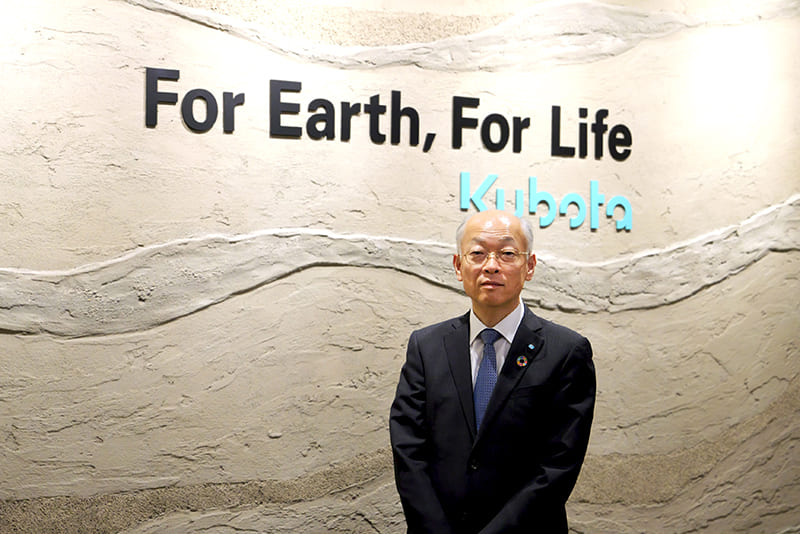
DNA for solving problems
Masato Yoshikawa
Director, president’s special missions
(formerly representative director and executive vice president in charge of ESG promotion)
In 2021, we placed “KESG,” a unique concept of ESG as interpreted and developed by Kubota, at the center of our management, and have been promoting it ever since.
Back in 2020 or so, when we worked out this policy, ESG and sustainability were buzzwords. We were already operating in the areas of food, water and the environment, and it was natural for us to work to reduce our environmental impacts. Most of all, our history was driving us.
Kubota was founded in 1890 by Gonshiro Kubota when cholera was still a major problem in Japan. Our founder decided to help solve this problem by supplying safe water through mass-producing water pipes and succeeded. Since then, Kubota has continued to provide solutions to social problems and issues through its products and services, including farm and construction machinery.
A look back on our history shows that providing solutions to emerging social issues has been our key theme since our foundation. I think it’s in our DNA, so to speak.
So, it was natural for us, when we worked out our medium- and long-term management plans in 2021, to place ESG at the center of our management and try to establish ESG itself as a business.
The farm and construction machinery sector, our core business, is full of challenges. The reality is that energy infrastructure remains underdeveloped and the adoption of new power sources, such as electrification and hydrogen engines, is still expanding only slowly.
However, we have a sense of crisis that if we do not work on the development of such products right now, we may not lead the market after a decade or two. Our wish is to still be growing 10 and 20 years from now. To realize this wish, we inevitably have to take on the challenges of shifting to products with lower environmental impacts and adopting the business of reducing environmental impacts.
We wish to take on the challenge of solving social issues while directly or indirectly engaging our stakeholders in the process, including our employees (naturally) and shareholders, business partners, the local communities we are involved with and, above all, the customers who buy our products and services.
The “S” in ESG represents not just “social” but also “stakeholders” — that is one of the unique ideas we came up with, and KESG reflects such ideas. If I were to describe KESG in one line, I might call it guidelines for resolving social issues through joint efforts by everybody involved.
What we want to do is to face social issues squarely while working to convince more stakeholders about KESG and engage them.
「食料・水・環境」を一体で課題解決。
〈クボタ〉が手がける農機・建機は世界120カ国以上に展開され、約3兆円(2023年12月期)の売上高のうち、海外売上比率は79%を占めるまでに成長した。サステナビリティへの対応でも評価を高めている。
2021年、2030年への長期ビジョン「GMB2030」および、2025年12月期までの「中期経営計画2025」を策定。クボタ流のESG「KESG」を経営の中核に据えた事業運営への転換を高らかに宣言した。
ディーゼルエンジンを主流とする農機・建機の低炭素化や脱炭素化は、乗用車に比べ遅れている。駆動時間などで劣るバッテリーや電動モーターを適用することが難しく、EV化へのハードルは高い。
とは言え、手をこまぬいて進歩を待っているわけではない。先回りして自社でできる研究開発を進めている。今、〈クボタ〉が注力しているのは「ピュアエンジン」「ハイブリッド」「フューエル」の3つのソリューション。それぞれ異なる角度から低炭素化・脱炭素化に挑んでいる。そのアプローチは多面的で隙がない。
Return to Sustainable Japan Magazine Vol. 45 article list page

